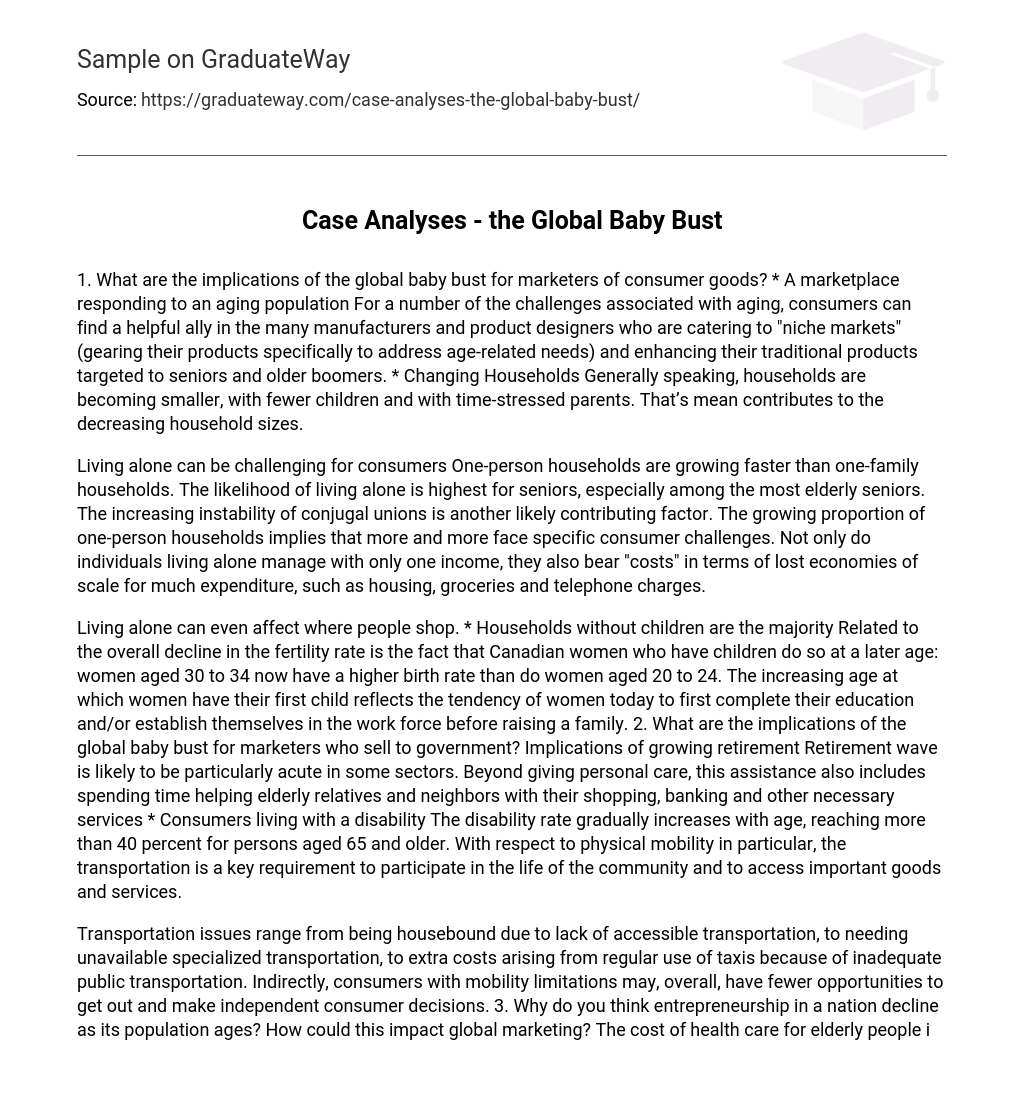1. What are the implications of the global baby bust for marketers of consumer goods? * A marketplace responding to an aging population For a number of the challenges associated with aging, consumers can find a helpful ally in the many manufacturers and product designers who are catering to “niche markets” (gearing their products specifically to address age-related needs) and enhancing their traditional products targeted to seniors and older boomers. * Changing Households Generally speaking, households are becoming smaller, with fewer children and with time-stressed parents. That’s mean contributes to the decreasing household sizes.
Living alone can be challenging for consumers One-person households are growing faster than one-family households. The likelihood of living alone is highest for seniors, especially among the most elderly seniors. The increasing instability of conjugal unions is another likely contributing factor. The growing proportion of one-person households implies that more and more face specific consumer challenges. Not only do individuals living alone manage with only one income, they also bear “costs” in terms of lost economies of scale for much expenditure, such as housing, groceries and telephone charges.
Living alone can even affect where people shop. * Households without children are the majority Related to the overall decline in the fertility rate is the fact that Canadian women who have children do so at a later age: women aged 30 to 34 now have a higher birth rate than do women aged 20 to 24. The increasing age at which women have their first child reflects the tendency of women today to first complete their education and/or establish themselves in the work force before raising a family. 2. What are the implications of the global baby bust for marketers who sell to government? Implications of growing retirement Retirement wave is likely to be particularly acute in some sectors. Beyond giving personal care, this assistance also includes spending time helping elderly relatives and neighbors with their shopping, banking and other necessary services * Consumers living with a disability The disability rate gradually increases with age, reaching more than 40 percent for persons aged 65 and older. With respect to physical mobility in particular, the transportation is a key requirement to participate in the life of the community and to access important goods and services.
Transportation issues range from being housebound due to lack of accessible transportation, to needing unavailable specialized transportation, to extra costs arising from regular use of taxis because of inadequate public transportation. Indirectly, consumers with mobility limitations may, overall, have fewer opportunities to get out and make independent consumer decisions. 3. Why do you think entrepreneurship in a nation decline as its population ages? How could this impact global marketing? The cost of health care for elderly people is greater than educational costs for the young. Hence, population aging will eventually place severe strains on government budgets for health care and pension plans, and with fewer workers to pay the taxes. * Health may actually decline due to the lifestyle changes of the urban environment, with its greater stresses and sedentary lifestyles.
At the same time, retirement means that income tax revenues required to fund these programs decline; the economy shrinks. For employers: there will have more employers on its pension rolls for each active worker and company have to pay for their pension plan increase every * Perhaps an aging workforce leads to less innovation. Capital investment may decline as elderly people cash in their investments to cover daily costs of living. * The effects of these transitions are likely to be especially harsh for developing economies. European countries at least had the opportunity to grow rich before they grew old; China may grow old before it can grow rich.
It may prove more difficult for developing countries to kick-start their economies once the aging populations of rich countries reduce their demand for consumer goods. * Another effect is the increase in births to older women: in Canada in 1998 the fertility rate was around 30 births per 1000 women aged 35-39. This rose to 45 births in 2007. * Population aging also depresses the growth of government revenues. Population growth is a major source of economic growth: more people create more demand for the products capitalists sell, and more supply of the labor capitalists buy . How does the global baby bust affect the relative attractiveness of different national markets? * Initially, the declining birth rates will bring economic benefits: a. Parents have more time to work and earn, increasing spending power, creating demand which stimulates production and jobs: the economy may expand. b. The appeal of radicalism and social tensions may also decline as young adults make up less of the population and as demand rises for their participation in the labour force. c.
Likewise, the aging population makes wars seem less likely as there are fewer young soldiers to fight. Mothers are likely to oppose the idea of losing their only son in a war. d. Without growing markets, individual firms have little incentive to learn how to do more with less — and with a dwindling supply of human capital, they have fewer ideas to draw on. e. Immigration turns out that importing new, immigration can work in the short term, but most immigrants are already in their adult years and will they become old relatively soon.
High ratios of immigrants can also create social tensions. Immigration, however, does less than one might think to ease the challenges of population aging. One reason is that most immigrants arrive not as babies but with a third or so of their lives already behind them — and then go on to become elderly themselves. In the short term, therefore, immigrants can help to increase the ratio of workers to retirees, but in the long term, they add much less youth to the population than would newborn children.





